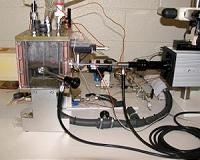 |
Toronto, Canada (SPX) Jul 27, 2010 A group of University of Toronto high-energy physicists, along with their 3,000 ATLAS colleagues, announced they have broken world records in the search for new particles as the first findings from the Large Hadron Collider (LHC) were presented this morning in Paris, France. The first results, following only three months of successful operation of the LHC, have "re-discovered" some of the familiar particles that lie at the heart of the Standard Model of physics. The Standard Model theory has formed the basis of theoretical particle physics for more than 30 years, explaining the particles of matter and the forces that bind them. The first results confirm that the Standard Model is working as expected. This is an essential step before the LHC moves on to new territory, including its ultimate goal of finding the Higgs Boson particle aka the God particle. If found, the Higgs Boson would fully satisfy the Standard Model theory. It would explain why all other known particles exhibit the mass they do and how all existing matter came to be. The scientists are also hoping to uncover the solution to the puzzle of mysterious dark matter that dominates the universe. The ATLAS collaboration, which includes 38 countries, produced many of the first results. ATLAS is a detector at the LHC that searches for new discoveries in the head-on collisions of extraordinarily high-energy protons. The Canadian contingent of ATLAS, and in particular its U of T members, played a key role in these searches by setting, with an exceptionally high degree of sensitivity, new limits on the mass of such new particles. Pierre Savard, a U of T physicist and TRIUMF scientist who is one of the two conveners of the Exotics physics group of the ATLAS collaboration, said of this result: "This is an important milestone for ATLAS and the LHC. It signals that we are now exploring uncharted territory at the high energy frontier". "This means that we can discard a host of theoretical models. Perhaps most importantly, it means that the LHC is now the discovery machine for the next decade," says team member U of T physicist, Pekka Sinervo. The Canadian team examined over 200 million proton-proton collisions, looking for collisions that produced particles hundreds of times heavier than ordinary matter. Various theories predict the existence of such objects, known as "excited quarks". If excited quarks were observed, it would turn the Standard Model on its head, revolutionizing scientists' understanding of matter and the forces that causes particles to bind together or interact in other ways. Finding no evidence of such particles, the team was able to exclude their existence below a mass of 1,290 GcV/c2 and so reconfirm allegiance to the Standard Model. The LHC, the world's largest particle accelerator was launched on March 27. Located in Switzerland, the collider has a circumference of 17 miles and is located 330 feet underground near the French-Swiss border. The LHC is still in its early days of operation, as it makes steady progress toward its ultimate operating conditions. The luminosity - a measure of the collision rate - has already risen by a factor of more than a thousand since the end of March. All U of T faculty members involved in the project have assisted in designing, building and operating the facility in Switzerland. Savard, who is internationally renowned for being at the centre of discoveries in exotic physics, and his students took leadership roles in the most recent results. He is currently spending two weeks per month coordinating scientific activities at the facility. Savard and his colleagues are also making use of the SciNet supercomputer installed at U of T in 2009 to analyse the huge volume of data involved in the project, an effort supported by Compute Canada, the Canada Foundation for Innovation and the Natural Sciences and Engineering Research Council of Canada. Scientists will get an opportunity to learn more about the first results of the LHC in August when the University of Toronto hosts the 2010 international Hadron Collider Physics Symposium.
Share This Article With Planet Earth
Related Links University of Toronto Powering The World in the 21st Century at Energy-Daily.com
 Nanowick At Heart Of New System To Cool 'Power Electronics'
Nanowick At Heart Of New System To Cool 'Power Electronics'West Lafayette IN (SPX) Jul 26, 2010 Researchers have shown that an advanced cooling technology being developed for high-power electronics in military and automotive systems is capable of handling roughly 10 times the heat generated by conventional computer chips. The miniature, lightweight device uses tiny copper spheres and carbon nanotubes to passively wick a coolant toward hot electronics, said Suresh V. Garimella, the R. ... read more |
|
| The content herein, unless otherwise known to be public domain, are Copyright 1995-2010 - SpaceDaily. AFP and UPI Wire Stories are copyright Agence France-Presse and United Press International. ESA Portal Reports are copyright European Space Agency. All NASA sourced material is public domain. Additional copyrights may apply in whole or part to other bona fide parties. Advertising does not imply endorsement,agreement or approval of any opinions, statements or information provided by SpaceDaily on any Web page published or hosted by SpaceDaily. Privacy Statement |